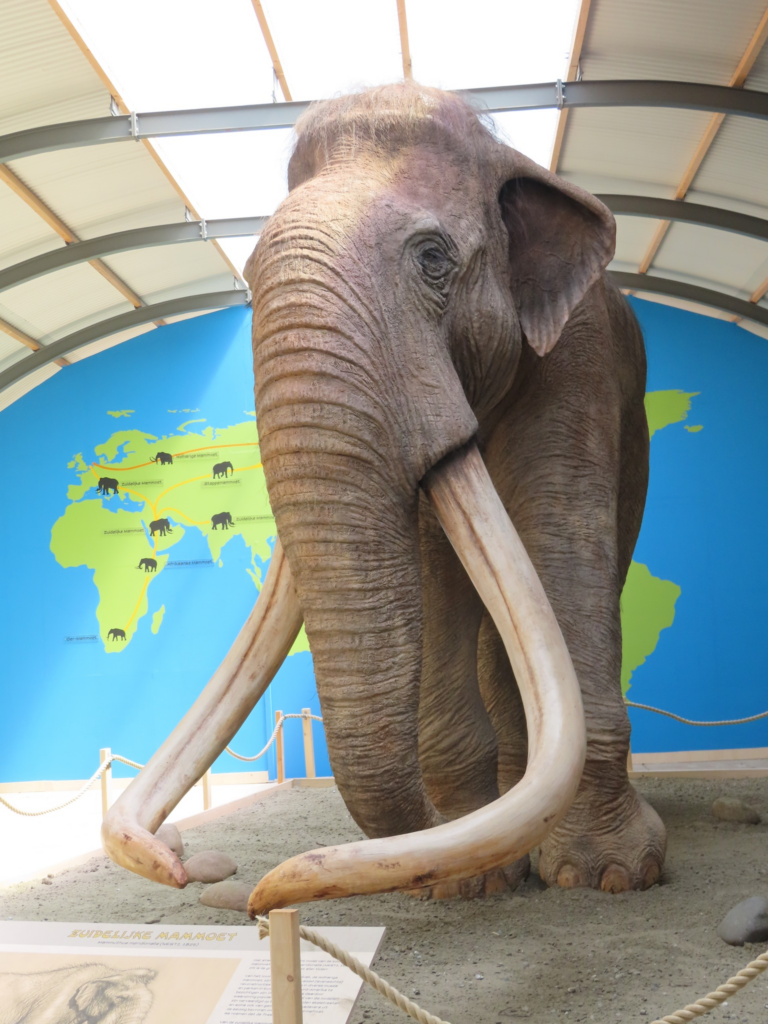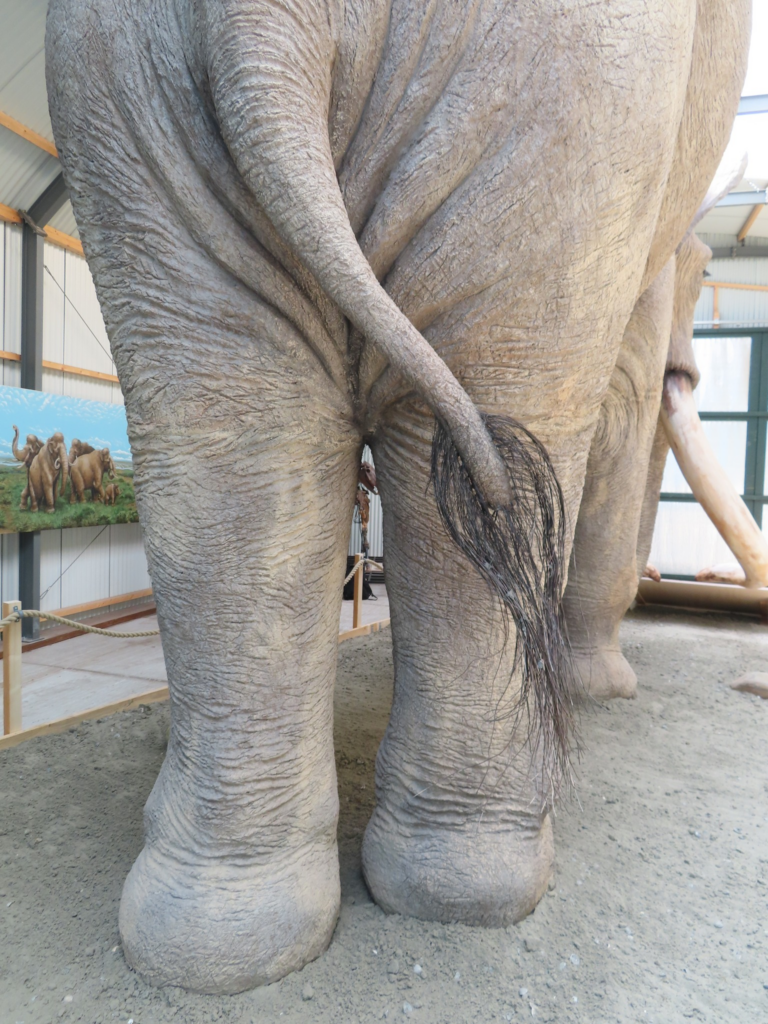Earlier this year, I made a trip to the Netherlands. One of my points of interest was Historyland in Hellevoetsluis, which is located western of Rotterdam. Historyland is an educational theme park which mainly focuses on different historic subjects, from naval history, to medieval and military history and – besides several other topis – paleontology. To cut a long story short, I have to say I was absolutely exited! The paleontological exhibition of Historyland is really world-class and can easily compete with all natural history museums I have ever visited! The main focus is on pleistocene mammals, but there are also various impressive fossils from other classes and ages. There are so many amazing fossils and reconstructions in that exhibition that I decided to make a series in which I want to feature several of the highlights. I visited the park with my good friends Dick Mol and his wife Friedje and had also the pleasure to get a private guided tour by the founder of Historyland, Arie van den Ban.
Dick is surely one of the biggest experts about prehistoric proboscideans and various other pleistocene mammals, in particular those known from the Doggerland. The ongoing design and development of the exhibition was made in charge of his expertise. As a result of this, the exhibition is highly informative and highly up-to-date (something that´s admittedly comparably often not the case in many museums where info plates sometimes haven´t changed for decades). It´s the type of museum which I love, with many, many specimens in the exhibition and a lot of information about them, something that sadly becomes in the modern world more and more rare. A lot of museums today focus on very few and isolated objects in their exhibition, often not even with info plates anymore. Luckily not in Historyland, the number of specimens is just staggering for the size of the exhibition. Another big asset is that the conditions to take photos are rather good for most of them. I emphasize this, because it can be utterly frustrating to see interesting specimens in a museum which are too far away to take good photos, which are partially hidden or which are exposed with too less or coloured light.
One of the absolute highlights is the life-sized reconstruction of a Southern mammoth (Mammuthus meridionalis). I don´t exaggerate when I say it was one of the most awesome reconstructions of a prehistoric animal I have ever seen. There are a lot of life reconstructions of wooly mammoths, and I´ve seen some other very good ones. But this southern mammoth is still different for several reasons. First of all, it´s absolutely huge. This reconstruction of a big bull towers with a shoulder height of 4,20 m above the visitors and dwarfs even a wooly mammoth, which averaged at about 2,70 m at the shoulder. A giant like this would have weighed about 8.000-10.000 kg.

Besides its impressive size, what makes it also different from other mammoths? Well, obviously the lack of a long shaggy fur. Mammuthus meridionalis, which lived around 2,5 million years ago, was no inhabitant of an ice-age tundra, but lived in comparably warm conditions in a partially tree-covered savannah-like landscape. Unlike wooly mammoths, which fed mainly on grass and herbs, the southern mammoth´s teeth show that it fed mainly on leaves and branches, and grass was very likely just a lesser important part of its diet. This animals must have had a tremendous impacts on their environment, since they were likely the most potent natural landscape designers. There are also other large herbivores which will feed on young trees, which break of branches or which even peel of the bark of larger trees. But no other animal can break off higher branches or log even bigger trees (beavers of course too, but they stay close to bodys of water, what limits their range of impact).

Fossils of this giants have been found in the North Sea, and this model in Historyland is the first life-sized reconstruction of its kind in the world. Reconstructions of wooly mammoths are usually nearly fully covered with fur, either synthetic fur or long fur from certain sheep breeds or muskoxen. This means that only comparably few parts of the whole model need a more detailed surface, for example around the facial parts and the trunk. But in this model literally every single square centimeter (except for three of the four soles) was bare and visible. So it was necessary to sculpt the surface of nearly the complete surface of that giant model. The artist, Jim van Dijk of Jim of Dijk Creations/Replica Wildlifeii did really a fantastic job here. There are so many fine details, skin wrinkles, additionally attached hairs, bristles, cornifications and much more that it appears nearly like a real taxidermy specimen.

The details of the skin shows quite well how incredibly much research and work went into this.
Another detail view:
The backside:
The mainly bare skin and the teeth adapted for browsing on shrubs and trees was however not the only thing that was different from the wooly mammoth. This was not just an especially large and furless mammoth, this was a unique animal which looked rather different from what we´re used to see in other proboscideans. The domed based of the trunk, which mus have been particularly thick, appears especially unfamiliar compared with extant elephants and wooly mammoths.

Before the work on the final model could start, Jim van Dijk made in january 2023 a maquette made from modelling clay at a scale of 1:10. It took one week under the supervision of Dick Mol until it was finished. In his atelier in Eersel near Eindhoven Jim van Dijk worked nearly for three months to finish the model, including four days to transport and assemble it at Historyland.
The construction of the model is also interesting, since it is not (as in many comparable cases) a fibreglass cast made with a mold from an original sculpted with modelling clay, but it was directly sculpted over a metal armature. If you are interested in the making-of this model I highly recommend you to watch this video by Jim van Dijk Creations:
Now this was part I about my visit of Historyland, but I plan to write some follow-ups about some of the other especially interesting specimens and life-reconstructions there.
At this point I also want to thank Dick, Friedje and Arie van den Ban for this fantastic day there. If I come again in this area, I really have to visit Historyland again, since I did not even manage to take a look at everything.





Dieser Beitrag von Markus Bühler über seinen Besuch im Historyland in Hellevoetsluis, Niederlande, ist äußerst faszinierend! Es ist inspirierend zu hören, dass das paleontologische Ausstellung im Historyland weltklasse ist und mit Naturkundemuseen weltweit konkurrieren kann. Die Tatsache, dass Dick Mol, ein Experte für prähistorische Rüsseltiere, maßgeblich an der Gestaltung der Ausstellung beteiligt war, verleiht ihr zusätzliche Glaubwürdigkeit und Aktualität. Es ist erfrischend zu wissen, dass es noch Museen gibt, die eine Vielzahl von Exponaten und ausführliche Informationen bieten, anstatt sich auf wenige isolierte Objekte zu beschränken. Ich freue mich darauf, mehr über die Highlights dieser Ausstellung in den kommenden Beiträgen zu erfahren!